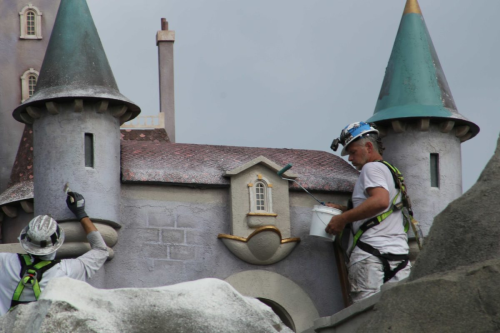Q
Anonymous asked:
How do open world games manage to feel so big? When you sit and look at them they're usually just a couple km per side, but they feel like a whole country at times. What're the tricks?
A
There’s a lot of small details and choices that combine together to make a world feel big. Each small thing isn’t enough to do it on its own, but with enough details working together the player will feel that sense of “bigness”. Most of these details are rules and expectations that humans have subconsciously internalized, things that we don’t necessarily think about but have taken as true.
The most common detail of “bigness” is visible size. Most areas in video games are already built larger than they would be for a real person of that size. Having buildings that are scaled larger than normal in video games contributes to a sense of grandeur. The SWTOR Jedi Temple on Tython, for example, is apparently built for giants. There’s no way that normal-sized humanoids could live or operate comfortably in a space that large, but the purpose isn’t a real living space, it’s to convey a sense of enormity and grandeur to the players who enter that space.
The amount of time it takes to navigate the area also contributes to the sense of how large a place is. If you think about traveling in real life, the metric of travel time is the most commonly used to determine how far away something is. This means that making travel time take longer actually makes something feel bigger, because our brains tell us “the longer it takes to get there means the further away it is”, even if it isn’t actually that far away. Look at how long it takes the player to approach the Colossus in this animation. It makes the colossus feel so much bigger because it takes so much longer to reach it.
We also often use tricks like forced perspective in certain places in order to make things feel bigger. If we have unreachable areas (e.g. cliffsides, mountain faces, etc.) that are still visible, we can use visual tricks to fool our brains into thinking things are further away or larger than they actually are. Without a reference point that can break the illusion, our minds will fill in the gaps by constructing its own consistent world view - that castle looks this big, so it must be this far away. The illusion above is only broken because we know roughly how tall a human is, so either the humans are giant or the buildings are tiny.
These various tricks (plus others that I haven’t talked about) work to stitch a cohesive experience together in the player’s mind. Your brain is being shown many things that have all subconsciously meant “big” to it before, so it assumes that its internal rules are still correct and the thing is big.
[Join us on Discord] and/or [Support us on Patreon]
Got a burning question you want answered?
- Short questions: Ask a Game Dev on Twitter
- Long questions: Ask a Game Dev on Tumblr
- Frequent Questions: The FAQ
Notes
 rotatedpotato liked this
rotatedpotato liked this  brandonvout reblogged this from askagamedev
brandonvout reblogged this from askagamedev  brandonvout liked this
brandonvout liked this yagodnyizefir liked this
 d-krian liked this
d-krian liked this forevervobla liked this
emissaryofwind reblogged this from lyriumrain
deadlikewwx liked this
lordbhreanna liked this
 vime5 liked this
vime5 liked this big-texts liked this
 mako-designated-driver liked this
mako-designated-driver liked this  soddingdeeproads liked this
soddingdeeproads liked this  butherlipsarenotmoving liked this
butherlipsarenotmoving liked this mewsly liked this
 hyperionhive reblogged this from felassan
hyperionhive reblogged this from felassan  boxcaroscar liked this
boxcaroscar liked this  gold-rydia reblogged this from coldbycrossfade
gold-rydia reblogged this from coldbycrossfade  lyriumrain reblogged this from felassan
lyriumrain reblogged this from felassan  lyriumrain liked this
lyriumrain liked this coldbycrossfade reblogged this from felassan
coldbycrossfade liked this
sarasa-cat reblogged this from felassan
sarasa-cat liked this
sunarctus liked this
theenmityofages liked this
jarino liked this
 aeli-tan-art liked this
aeli-tan-art liked this  chride liked this
chride liked this califrey liked this
 undermounts liked this
undermounts liked this  maternalcube liked this
maternalcube liked this  dreadfutures liked this
dreadfutures liked this  angelic-anissa reblogged this from felassan
angelic-anissa reblogged this from felassan  angelic-anissa liked this
angelic-anissa liked this felassan reblogged this from askagamedev
felassan liked this
tree-of-crowns liked this
therealbrigeedarocks liked this
miniaturetyphoonhologram reblogged this from askagamedev
miniaturetyphoonhologram liked this
supercomputer276 reblogged this from askagamedev
isayoldbean liked this
madalpaca reblogged this from askagamedev
madalpaca liked this
thebeigeoverlord reblogged this from askagamedev
thebeigeoverlord liked this
 askagamedev posted this
askagamedev posted this How do open world games manage to feel so big? When you sit and look at them they're usually just a couple km per side,...
- Show more notes




